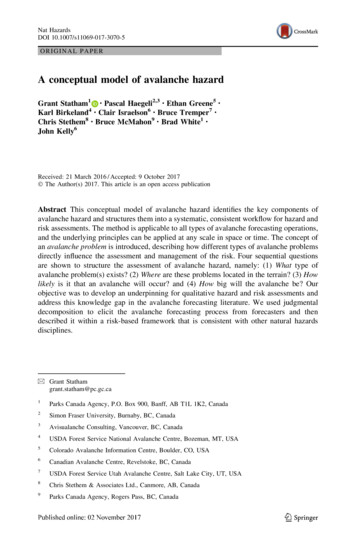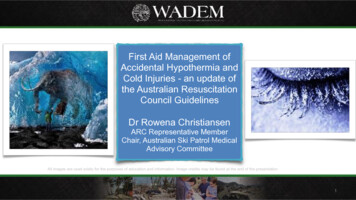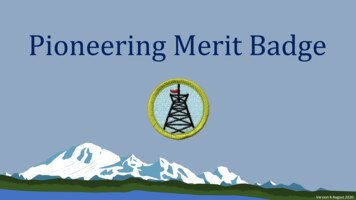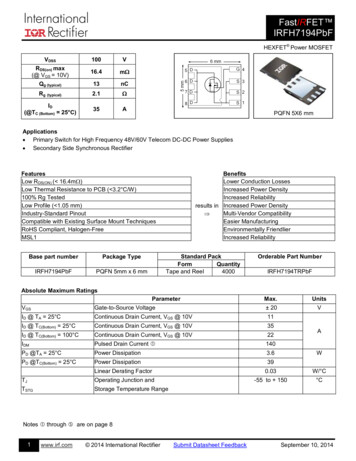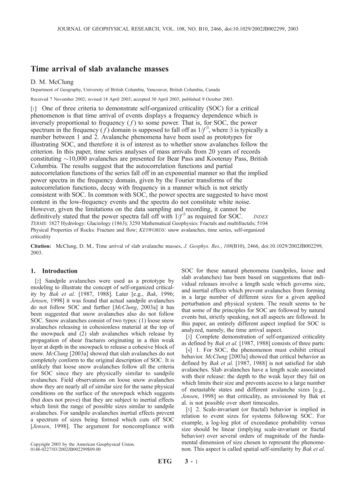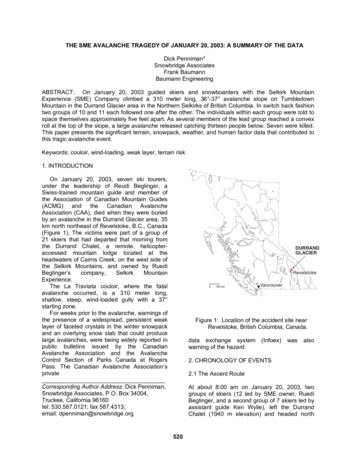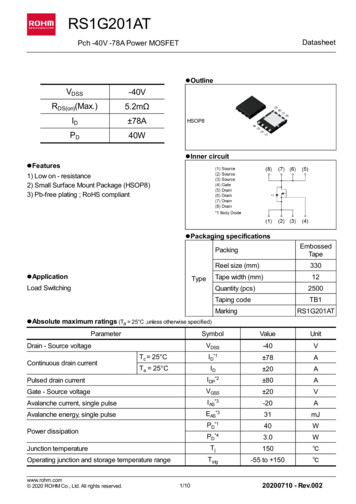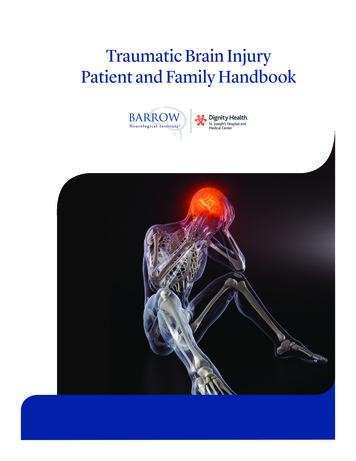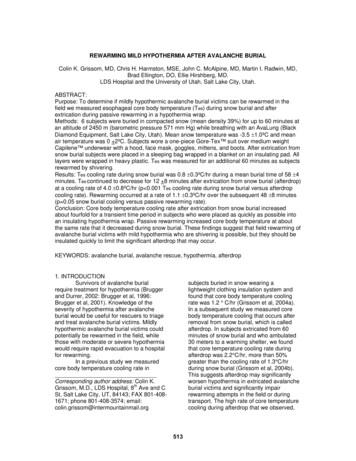
Transcription
REWARMING MILD HYPOTHERMIA AFTER AVALANCHE BURIALColin K. Grissom, MD, Chris H. Harmston, MSE, John C. McAlpine, MD, Martin I. Radwin, MD,Brad Ellington, DO, Ellie Hirshberg, MD.LDS Hospital and the University of Utah, Salt Lake City, Utah.ABSTRACT:Purpose: To determine if mildly hypothermic avalanche burial victims can be rewarmed in thefield we measured esophageal core body temperature (Tes) during snow burial and afterextrication during passive rewarming in a hypothermia wrap.Methods: 6 subjects were buried in compacted snow (mean density 39%) for up to 60 minutes atan altitude of 2450 m (barometric pressure 571 mm Hg) while breathing with an AvaLung (BlackDiamond Equipment, Salt Lake City, Utah). Mean snow temperature was -3.5 1.0ºC and meanair temperature was 0 2ºC. Subjects wore a one-piece Gore-Tex suit over medium weightCapilene underwear with a hood, face mask, goggles, mittens, and boots. After extrication fromsnow burial subjects were placed in a sleeping bag wrapped in a blanket on an insulating pad. Alllayers were wrapped in heavy plastic. Tes was measured for an additional 60 minutes as subjectsrewarmed by shivering.Results: Tes cooling rate during snow burial was 0.8 0.3ºC/hr during a mean burial time of 58 4minutes. Tes continued to decrease for 12 8 minutes after extrication from snow burial (afterdrop)at a cooling rate of 4.0 0.8ºC/hr (p 0.001 Tes cooling rate during snow burial versus afterdropcooling rate). Rewarming occurred at a rate of 1.1 0.3ºC/hr over the subsequent 48 8 minutes(p 0.05 snow burial cooling versus passive rewarming rate).Conclusion: Core body temperature cooling rate after extrication from snow burial increasedabout fourfold for a transient time period in subjects who were placed as quickly as possible intoan insulating hypothermia wrap. Passive rewarming increased core body temperature at aboutthe same rate that it decreased during snow burial. These findings suggest that field rewarming ofavalanche burial victims with mild hypothermia who are shivering is possible, but they should beinsulated quickly to limit the significant afterdrop that may occur.KEYWORDS: avalanche burial, avalanche rescue, hypothermia, afterdrop1. INTRODUCTIONSurvivors of avalanche burialrequire treatment for hypothermia (Bruggerand Durrer, 2002: Brugger et al, 1996:Brugger et al, 2001). Knowledge of theseverity of hypothermia after avalancheburial would be useful for rescuers to triageand treat avalanche burial victims. Mildlyhypothermic avalanche burial victims couldpotentially be rewarmed in the field, whilethose with moderate or severe hypothermiawould require rapid evacuation to a hospitalfor rewarming.In a previous study we measuredcore body temperature cooling rate inCorresponding author address: Colin K.Grissom, M.D., LDS Hospital, 8th Ave and CSt, Salt Lake City, UT, 84143; FAX 801-4081671; phone 801-408-3574; email:colin.grissom@intermountainmail.orgsubjects buried in snow wearing alightweight clothing insulation system andfound that core body temperature coolingrate was 1.2 C/hr (Grissom et al, 2004a).In a subsequent study we measured corebody temperature cooling that occurs afterremoval from snow burial, which is calledafterdrop. In subjects extricated from 60minutes of snow burial and who ambulated30 meters to a warming shelter, we foundthat core temperature cooling rate duringafterdrop was 2.2 C/hr, more than 50%greater than the cooling rate of 1.3 C/hrduring snow burial (Grissom et al, 2004b).This suggests afterdrop may significantlyworsen hypothermia in extricated avalancheburial victims and significantly impairrewarming attempts in the field or duringtransport. The high rate of core temperaturecooling during afterdrop that we observed,513
measured the weight of water per cubicmeter (kg/m3). Snow density is reported asa percent (i.e. 300 kg/m3 is 30% densitysnow). Mean snow density was 39 3%.Snow temperature was measured with adual thermocouple thermometer (Model 6001040, Barnant Company, Barrington, IL).Mean snow temperature was – 3.5 1 C. Ashoulder width trench was dug into one endof the snow mound and a sitting platformcreated for the subject so that the headwould be approximately 50 cm under the topsurface of the mound after burial. Figure 1shows the experimental burial site with asubject during extrication at the end of astudy burial.however, may have been due to ambulationof the subjects from the study site to arewarming area, because exercise is knownto increase afterdrop in studies of immersionhypothermia (Giesbrecht et al, 1987). Wetherefore designed this current study tomeasure core temperature afterdrop insubjects who are immediately packaged fortransport in an insulating hypothermia wrapafter extrication from snow burial.Our previous studies also suggestthat avalanche burial victims buried forperiods of up to one hour, and who areextricated alive, should only have mildhypothermia (32 to 36 C) if core bodytemperature was normal (37 C) at the timeof burial. Mildly hypothermic avalancheburial victims extricated alive should exhibitvigorous shivering. Studies of immersionhypothermia show that it is possible formildly hypothermic persons to rewarm byshivering alone if dry insulation is provided,a method known as passive rewarming(Giesbrecht et al, 1987). We also designedthis study to determine whether passiverewarming could attenuate afterdrop andrewarm subjects after extrication from snowburial.In this study we hypothesized thatafterdrop can be limited and passiverewarming can occur in subjects extricatedfrom 60 minutes of burial in dense snow. Inorder to test this hypothesis we measuredcore body temperature in subjects buried indense snow for up to 60 minutes. Wecontinued to measure core bodytemperature for an additional 60 minutesafter extrication from snow burial as subjectswere placed in an insulating hypothermiawrap at the study site and allowed to rewarmby shivering alone.Figure 1. The study site with a subjectburied in a mound of dense compactedsnow while breathing with an AvaLung ascore body temperature is monitored. At theend of 60 minutes the subject is extricatedfrom snow burial.2. STUDY SITEThis study was performed at 2450 melevation (average barometric pressure, 571 3 mm Hg) at The Canyons ski resort in theWasatch Mountains, Utah, during the wintermonths of 2005. Average ambient airtemperature was 0 2 C during the studies.The experimental set-up consisted of a largemound of snow compacted with body weightand allowed to age harden for approximatelytwo hours. Snow density was determined inmultiple sites using a 1000 cc wedge densitycutter (Snowmetrics, Ft. Collins, CO) that514
Figure 3. Side view of a subject duringextrication from burial at the end of a study.Figure 2. The breathing device used duringthe snow burial is shown (AvaLung 2 ,Black Diamond Equipment, Ltd., Salt LakeCity, UT). White arrows show flow ofinspiratory air, and dark arrows show flow ofexpiratory air. The subject breathes in andout through the mouthpiece (A). Anemergency oxygen back-up line (B) isattached directly into the mouthpieceapparatus and is used only if the subjectbecomes hypoxemic or requests to end thestudy. Monitoring lines (C, D) are connectedto a device for measuring and recordinginspired carbon dioxide (PICO2), expiredcarbon dioxide (ETCO2), and minuteventilation (respiratory rate times tidalvolume of each breath VE). Inhaled airenters from the snowpack through the 1-wayinspiratory valve on the side of the housinginside the mesh-protected harness on thechest (E). Expired air leaves the lungsthrough the mouthpiece and travels downthe respiratory tubing to the housing andthen passes through an expiratory 1-wayvalve located at the bottom of the housing(E) and travels via respiratory tubing insidethe harness around to the back (F).Figure 4. Front view of a subject duringextrication from burial showing the AvaLungbreathing device.515
electrocardiogram (ECG). Ventilationparameters measured included partialpressure of end-tidal (expired) carbondioxide (ETCO2) and partial pressure ofinspired carbon dioxide (PICO2) in mm Hg,minute ventilation (VE) in l/min (minuteventilation is respiratory rate multiplied bythe volume of each breath) and percentsaturation of hemoglobin with oxygen(SaO2) (CO2SMO Plus, model 8100,Novametrix, Wallingford, CT). Fraction ofinspired carbon dioxide (FICO2) wasobtained by dividing PICO2 by ambientbarometric pressure. Arterial oxygensaturation (SaO2) was measured by fourdifferent pulse oximeters (Propaq Encore,CO2SMO Plus, and two Masimo SET Rad5s, one with a finger and the other with aforehead probe, Masimo Corporation, Irvine,CA ).Immediately prior to burial subjectsmade a brisk uphill walk for 5 minutes andthen returned to the study area where theywere rapidly buried while sitting in the snowmound trench and breathing on theAvaLung. Snow was rapidly and denselycompacted around their bodies until theywere completely buried and immobile.Subjects were in communication with thesurface team via intercom. Time –60minutes of burial was noted when thesubject’s head was completely buried.During the burial subjects couldcommunicate with the surface team viaintercom if necessary. The study burial wasterminated after 60 minutes, or when SaO2fell to 85%, or when core temperaturedropped below 35 C, or at the subject’srequest. An emergency oxygen backup linewas attached to the breathing devicemouthpiece and could deliver 15 l/min of100% oxygen.After 60 minutes of burial subjectswere extricated from the snow (time 0) andthen immediately placed in a syntheticsleeping bag wrapped in a wool blanket onan foam pad (Figure 5). A heavy plasticvapor barrier was then wrapped around thewool blanket, sleeping bag, and foam pad.Core body temperature was monitored foran additional 60 minutes (to time 60).3. METHODSSubjects were fully buried in thesnow for up to 60 minutes while breathingwith an artificial device (AvaLung 2 , BlackDiamond Equipment Ltd, Salt Lake City,Utah). After 60 minutes of snow burialsubjects were extricated and immediatelywrapped in insulating material and thenallowed to rewarm by shivering for 60minutes.Subjects were healthy paidvolunteers, 3 women and 3 men, mean age27 3 years, mean height 174 5 cm, meanweight 66 4 kg, mean BMI 22 1. Allsubjects wore an identical lightweightclothing insulation system consisting of aone-piece Gore-tex suit (Patagonia,Ventura, CA) over medium weightCaplilene underwear (Patagonia), a hoodand facemask with goggles, mittens andwarm boots. The LDS Hospital Researchand Human Rights Committee approved thisstudy, and written informed consent wasobtained from volunteers.During snow burial subjectsbreathed through an artificial device thatdraws inspired air from the snowpack infront of the subject’s chest and divertsexpired air into the snowpack behind thesubject (Figure 2-4). This device is used bysome persons traveling in avalanche terrainand is intended to prolong survival duringavalanche burial (AvaLung 2 , BlackDiamond Equipment). In a previous studyour group demonstrated that subjectsbreathing with this device during snow burialmaintained adequate oxygenation for up to60 minutes but gradually developedhypercapnia (high blood carbon dioxide)(Grissom et al, 2000).Physiologic parameters werecontinuously monitored during the burialstudies and were recorded every minute.These parameters included esophageal corebody temperature (Tes) in C obtained by aprobe inserted through the nose and into theesophagus with the tip at the level of theheart. Core body temperature was alsomeasured with a rectal probe (Tre) insertedto 15 cm. Esophageal and rectaltemperature probes (model 401, YSIIncorporated, Yellow Springs, OH) wereattached to a monitor (Propaq Encore,Protocol Systems Incorporated, Beaverton,OR) that also monitored surface three lead516
the start of burial occurred at minus thenumber of minutes of the duration of theirstudy burial. Both Tes and Tre were recordedand are reported for comparison, but Tes isprimarily used for data analysis due to theknown lag of Tre during rewarming.Cooling rate in C/hr was calculatedarithmetically using the Tes at extrication andTes at the time of burial. Afterdrop coolingrate in C/h was calculated arithmetically byusing the nadir in afterdrop Tes and the Tesat extrication. Rewarming rate in C/hr wascalculated arithmetically by using the nadirin afterdrop Tes and the end study (60minutes after extrication) Tes. Afterdropcooling rate was compared to cooling rateduring snow burial by a paired t-test. Coolingrate during snow burial and rewarming rateafter the nadir of afterdrop were comparedusing a paired t-test. P 0.05 was consideredstatistically significant. Data are reported asmean standard deviation (SD).Figure 5. At the end of the 60 minute snowburial the subject is immediately placed in asleeping bag wrapped in a wool blanket on afoam pad and then wrapped in a heavyplastic vapor barrier. Core body temperatureis monitored for 60 minutes as the subjectpassively rewarms by shivering.4. RESULTSTes cooling rate during snow burialwas 0.84 0.3 ºC/hr during a mean burialtime of 58 4 minutes (Figure 6). Tesafterdrop occurred over 12 8 minutes afterextrication from snow burial with a Tescooling rate of 4.0 0.8 ºC/hr (p 0.001 snowburial as compared to afterdrop coolingrate). Even though cooling rate duringafterdrop was 4.0 0.8 ºC/hr, the shortduration (12 8 minutes) resulted in a meanafterdrop of 0.8 0.4ºC. Rewarmingoccurred after the nadir of the Tes afterdropat a rate of 1.1 0.3 ºC/hr over thesubsequent 48 8 minutes during passiverewarming (p 0.05 snow burial as comparedto Tes passive rewarming rate).Tre cooling rate during snow burialwas similar to Tes. Tre afterdrop was 0.7 0.5ºC/hr (p 0.5 compared to Tesafterdrop), and the nadir of Tre afterdrop wasat 26 15 minutes (p 0.13 compared to Testime to afterdrop nadir). Tre afterdrop coolingrate was 1.8 1.9ºC/hr (p 0.07 compared toTes afterdrop cooling rate). Tre rewarmingrate significantly lagged behind Tes.During snow burial inspired CO2increased from 0.4 0.6% to 4.9 2.1%(p 0.005), end tidal CO2 increased from 38 2 to 52 10 mm Hg (p 0.03), and minuteventilation increased from 14 2 to 33 9liters/min (p 0.008). SaO2 decreased from97 1 % to 91 5 % (p 0.02).Statistical AnalysisAll data was compared using time 0of extrication so that if a subject’s snowburial portion of the study was less than 60minutes, their data was adjusted so that endburial occurred at time 0 (extrication) and517
Temperature op35.5Rectal Core Temperature35.0Esophageal Core Temperature34.5-60-40-2002040Time Relative to Extrication (minutes)Figure 6. Esophageal (Tes) and rectal (Tre) core temperatures during snow burial and afterextrication during passive rewarming. The Tes probe is at the level of the heart and most closelyrepresents the “core” body temperature. Tes and Tre show about the same cooling rate duringsnow burial from minutes –60 to 0. Then at extrication from snow burial both Tes and Tre show anafterdrop, but the afterdrop of Tes is attenuated and the Tes shows rewarming of the core asinsulation is provided to the shivering subject. Tre lags behind Tes during rewarming representingtemperature gradients from the body core to the body shell as rewarming occurs. The findingssuggest that core cooling rates during avalanche burial will cause only mild hypothermia duringburials of up to about one hour in duration, significant afterdrop can occur in avalanche burialvictims after they are extricated from snow burial and insulation should be provided as quickly aspossible, and that avalanche burial victims who are awake and shivering after extrication fromsnow burial can be rewarmed in the field using passive rewarming methods (providing insulationand allowing shivering to rewarm the avalanche burial survivor).51860
activity after extrication from avalancheburial should be avoided in order to limitafterdrop, this is not always possible forsafety or logistical reasons, and extricatedavalanche victims may need to ambulate inorder to move to a location away fromfurther avalanche danger or self evacuatefrom a backcountry location when a rescuelitter and rescue team are not available. In aprevious study (Grissom et al, 2004b) wesimulated this situation and providedestimates of core temperature afterdrop thatmight occur in rescued avalanche burialvictims who ambulate for short distances of30 meters or less, and we found that Trecooling rate during afterdrop was 2.2 1.3ºC/hr, similar to the Tre afterdrop coolingrate in this study.Hypothermia is the major medicalproblem requiring treatment in survivors ofavalanche burial. Knowledge of coretemperature cooling rate during avalancheburial would help rescue personnel estimatethe severity of hypothermia and provideappropriate treatment for survivors. Fewprevious studies report core bodytemperature cooling rate during avalancheburial. Locher and Walpoth retrospectivelystudied 32 avalanche accidents where meanburial times and mean transport times to thehospital were over 60 minutes, andestimated that core body temperaturecooling rate averaged 3 C/h from the time ofburial in the avalanche to arrival at a hospital(Locher and Walpoth, 1996). Braun reporteda similar average cooling rate over the timeof burial and transport to a hospital in aretrospective analysis of five avalancheburial survivors (Braun, 1976). In the studythat we report here, and in previous studies,we observed a lower core temperaturecooling rate during snow burial of 0.8 to1.3ºC/h (Grissom et al, 2004a: Grissom etal, 2004b). The difference in cooling ratesbetween our studies and that of Locher andWalpoth might be explained by the rate ofcore temperature cooling after extricationfrom avalanche burial. The higher coretemperature cooling rate reported by Locherand Walpoth included cooling duringavalanche burial and after extrication duringtransport to a hospital. Cooling rate mayhave been higher after extrication due tocore temperature afterdrop. Rapid coretemperature afterdrop in extricatedavalanche burial victims has been reported5. DISCUSSIONWe found that in subjects buried indense snow for up to 60 minutes core bodytemperature cooling rate was 0.84 0.3ºC/hr. After extrication from snow burialafterdrop core cooling rate significantlyincreased to four times the cooling rateduring snow burial (4.0 0.8ºC/hr), butafterdrop was attenuated after just 12 8minute thus limiting afterdrop to 0.8 0.4ºC.Passive rewarming increased coretemperature at slightly faster rate than itdecreased during snow burial (rewarmingrate 1.1 0.3ºC/hr, p 0.05 compared tocooling rate).The findings in our study suggestthat a mildly hypothermic and shiveringavalanche burial survivor can be rewarmedin the filed if adequate insulation is provided.Our study also suggests that providinginsulation as soon as possible to anavalanche burial victim is important to limitafterdrop. The possible mechanisms for theincreased cooling rate during afterdrop inour study include conduction, convection, orincreased activity by the subject uponextrication from snow burial. Exercise isknown to cause increased afterdrop due toincreased blood flow to cold peripheraltissues and cooling of the blood beforereturning to the heart (Giesbrecht et al,1987). The abrupt increase in core coolingrate during afterdrop after extrication fromsnow burial suggests that increased activityand circulation of blood to cool extremitieswas the primary mechanism for afterdrop inour study (Mittleman and Mekjavic, 1988).This is consistent with the higher Tesafterdrop cooling rate that was acceleratedby cold blood returning to the heart ascompared to the Tre afterdrop cooling rate.Conductive cooling would have occurred atthe same rate, or slower, as cooling duringsnow burial, and convective cooling wouldalso be slower, especially in subjectswearing a one piece Gore-Tex suit.The core temperature afterdrop inour study has important implications formedical care of avalanche burial victims. Ifpossible, an avalanche burial victim shouldbe insulated, kept supine, and placed in arescue litter as quickly as possible afterextrication from snow burial in order to limitafterdrop and potential complications fromhypothermia. Although increased physical519
from clinical observations by Brugger andcolleagues (Brugger et al, 1996), and issuggested by our observations of coretemperature afterdrop in this study.Lower cooling rates duringavalanche burial have been reported whencore body temperature is measured at thescene of avalanche accidents duringextrication of a victim (Spiegel, 2002). A 25year old male snowboarder survivedavalanche burial for 20 hours with a large airpocket in front of his body and at the time ofextrication had a core body temperature of25.6 C (tympanic) in –5 C temperaturesnow and was spontaneously breathing witha Glasgow Coma Score of 8, heart rate 35,and a palpable pulse. Core bodytemperature cooling rate in this anecdotalreport was about 0.6 C/hr, even lower thanthe cooling rates measured in our studiesduring snow burial.In the controlled experimental set upin our study some factors that may occur inactual avalanche burial cannot be duplicatedfor safety reasons and core temperaturecooling rate during actual avalanche burialmay vary more than in our study. Avalancheburial victims may be unconscious or havetraumatic injuries that could influencethermoregulation and increase coretemperature cooling rate. Differences inclothing insulation may increase or decreasecore temperature cooling rate. Duringprolonged burial core temperature coolingrate may not be linear and may plateau oraccelerate below the core temperaturesobserved in our study. Persons buried in anavalanche may become more hypoxic thanthe subjects in our study, which may furtheraccelerate core temperature cooling ratebecause hypoxia, independent ofhypercapnia, can accelerate coretemperature cooling rate (Johnston et al,1996).The artificial breathing device usedin the hypercapnic burials in our study isworn by some persons traveling in high-riskavalanche terrain for use as an emergencybreathing device if they are caught andburied in an avalanche. Survival afteravalanche burial using this device hasoccurred (Radwin and Grissom, 2002). Theresults from our study may be applied byrescue personnel to estimate the severity ofhypothermia in persons using this device forbreathing after avalanche burial, or forpersons buried in an avalanche breathingwith an air pocket in the snow. Our studysuggests that avalanche burial victims withan air pocket or an artificial breathing devicewho are extricated alive within an hour willonly be mildly hypothermic and can berewarmed in the field. In contrast, the resultsof our study may not be directly applicable toavalanche burial victims without an airpocket or an artificial breathing device.6. CONCLUSIONSCore body temperature cooling rateafter extrication from snow burial increasedabout fourfold for a transient time period insubjects who were placed as quickly aspossible into an insulating hypothermiawrap, but afterdrop was attenuated after amean of only 12 minutes. Passiverewarming from shivering alone increasedcore body temperature at a slightly higherrate than it decreased during snow burial.This suggests that field rewarming ofavalanche burial victims with mildhypothermia who are shivering is possible,but they should be insulated quickly to limitthe significant afterdrop that can occur. Anaccelerated afterdrop cooling rate placesavalanche burial survivors at greater risk ofcomplications due to hypothermia. This isimportant information for rescue personnelwho should keep the avalanche burial victimsupine and provide insulation as quickly aspossible in order to prevent further heat lossafter extrication from the snow.7. ACKNOWLEDGEMENTSThis study was supported by grantsfrom The Heart & Lung Foundation of LDSHospital and the Wilderness MedicalSociety. The authors thank Black DiamondEquipment, Ltd., for donating the artificialbreathing device, the AvaLung, for use inthis study; and The Canyons, Snowbird, andDeer Valley ski resorts for allowing us toconduct this study at their ski areas. Theauthors also thank Abigail Wright Grissomfor critical review of the manuscript.520
Locher, T. and B. H. Walpoth, 1996:Differential diagnosis of circulatory failure inhypothermic avalanche victims:retrospective analysis of 32 avalancheaccidents. Schweiz Rundsch Med Prax, 85,1275-1282.8. REFERENCESBraun, P. H., 1976: Probleme der ErstenHilfe beim Lawinenunfall. Tagung UberMedizinische Aspekte des Lawinenunfalls.Kantonsspital Zurich., Juris Druck andVerlag, 89-96.Mittleman, K. D. and I. B. Mekjavic, 1988:Effect of occluded venous return on coretemperature during cold water immersion. JAppl Physiol, 65, 2709-13.Brugger, H. and B. Durrer, 2002: On-sitetreatment of avalanche victims ICARMEDCOM-Recommendations. High AltitudeMedicine & Biology, 3, 421-425.Radwin, M. I. and C. K. Grissom, 2002:Technological advances in avalanchesurvival. Wilderness Environ Med, 13, 143152.Brugger, H., B. Durrer, and L. Adler-Kastner,1996: On-site triage of avalanche victimswith asystole by the emergency doctor.Resuscitation, 31, 11-16.Spiegel, R., 2002: Rescuing an avalanchevictim alive after 20 hours. Airmed 2002,Interlaken, Switzerland, Rega (available onCD-ROM from Airmed 2002 c/o Rega, CH8058 Zurich Airpot, Switzerland).Brugger, H., B. Durrer, L. Adler-Kastner, M.Falk, and F. Tschirky, 2001: Fieldmanagement of avalanche victims.Resuscitation, 51, 7-15.Giesbrecht, G. G., G. K. Bristow, A. Uin, A.E. Ready, and R. A. Jones, 1987:Effectiveness of three field treatments forinduced mild (33.0 degrees C) hypothermia.J Appl Physiol, 63, 2375-9.Grissom, C. K., M. I. Radwin, C. H.Harmston, E. L. Hirshberg, and T. J.Crowley, 2000: Respiration during snowburial using an artificial air pocket. JAMA,283, 2261-2271.Grissom, C. K., M. I. Radwin, M. B.Scholand, C. H. Harmston, M. C.Muetterties, and T. J. Bywater, 2004:Hypercapnia increases core temperaturecooling rate during snow burial. J ApplPhysiol, 96, 1365-1370.Grissom, C. K., J. C. McAlpine, C. H.Harmston, M. I. Radwin, M. B. Scholand, J.S. Morgan, and T. J. Bywater, 2004: Effectof hypercapnia on core body temperaturecooling rate during and after simulatedavalanche burial (abstract). WildernessEnviron Med, 15, 59.Johnston, C. E., M. D. White, M. Wu, G. K.Bristow, and G. G. Giesbrecht, 1996:Eucapnic hypoxia lowers human coldthermoregulatory response thresholds andaccelerates core cooling. J Appl Physiol, 80,422-9.521
dual thermocouple thermometer (Model 600-1040, Barnant Company, Barrington, IL). Mean snow temperature was - 3.5 1 C. A shoulder width trench was dug into one end of the snow mound and a sitting platform created for the subject so that the head would be approximately 50 cm under the top surface of the mound after burial. Figure 1

